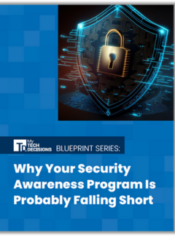Modern Information Technology practices are a moving target. For businesses that are not focused on continually advancing the technology tools they are using, it’s easy to get left behind. With continuous improvement in mind, it’s good to take a step back to look at the bigger picture. How is IT changing? And what will 2020 look like?
From cloud connectivity to maximizing security operations, IT has come a long way in the past few years and is still transforming.
Following are seven enterprise IT trends to know heading into the new year inspired by our work in DevOps, digital transformation, data center, cloud, and managed services alongside inspiration from Gartner IT Symposium/Xpo and industry thought leaders.
1) Data driven decision making
Over 98% of executives indicated they aspire to a data-driven culture, but only 32% report having success, says research from New Vantage Partners. Asking the right questions, ensuring resources, staff alignment and support are just a few of the challenges.
The quest for analytics-informed decisions can be a difficult one. I like to boil this down as, “What do I need to know? Who needs to know it? Have I told them yet?”
But there are many other questions that go into BI.
Which metrics are important to measure? How often should I report? What tools do I need? And maybe most difficult – what data do I collect, and how do I find data to compare myself to the market?
Many organizations are working through these questions to lead the charge into analytics-based decision making. BI continues to grow in importance as spending on a wide array of services to modernize and automate the business grows.
We must determine which initiatives are delivering business value and back it up with metrics.
2) Continually reviewing tech’s ability to achieve business outcomes
This goes hand-in-hand with BI and becoming more data-driven, and the popular buzzwords “continuous improvement.” IDC predicts that in 2020, over 50% of organizations will be “digitally determined,” with an integrated digital strategy and roadmap.
And Gartner says that a key factor in the coming year will be the ability to strategically engage IT to gain a competitive advantage and prepare for potential organizational disruptions.
The only way to constantly iterate and improve upon processes, human capital, and technology is to be continuously reviewing, benchmarking, and adjusting strategy accordingly.
We’re far past the time where you could buy a few servers and run them for 5+ years with the same software stack. Disruptive tech is released regularly. IT leadership must evaluate how it fits
into their strategy moving forward to ultimately help the organization become more productive by supporting real business outcomes.
3) Evaluate & introduce disruptive technologies for the business
That brings me to the next of the enterprise IT trends, which is the evaluation, testing, and deployment of disruptive technologies like serverless computing, Infrastructure as Code, or automated deployment and management of IT resources.
Gartner predicts that the greatest source of competitive advantage for 30% of organizations will be their workforce’s ability to creatively exploit emerging technologies.
Many emerging technologies—such as AI, analytics, IoT, etc.—involve huge changes to the way we roll out and manage infrastructure and applications.
And even relatively more benign tech can cause disruption, like the introduction of a multi-cloud management tool or redesigning a legacy application to run in the cloud.
A strong CIO or CTO is constantly exploring new technologies that could be useful within the organization. A lab environment is easier than ever to configure in the cloud. Are you experimenting enough?
4) Lock in strategy around platform & cloud connectivity
With key business activities hinging on access to platform as a service (PaaS) and software as a service (SaaS), connectivity has become even more vital.
Networks must work flawlessly to avoid user disruption or, even worse, downtime for critical systems that process transactions or handle logistics, databases, resource management, and other functions that can completely ground operations and hurt the bottom line and reputation.
While the cost of downtime is estimated at being about $5,600 per minute, this can be slightly lower or much higher depending on the characteristics of the business environment.
Data transit costs can be high. Organizations need to consider how they are moving information to and from hosted platforms. Latency between services might have a ripple effect.
Do you need direct cloud connect? Tech leadership needs to have a strong, long-term strategy around connectivity beyond reliable networks. Organizations should not just plan for current usage, but what they anticipate a few years down the road.
5) Multi-cloud strategy is becoming increasingly important
There are a multitude of cloud services in use at most enterprises.
It was interesting to hear Gartner start to shift messaging from “cloud is the only option” to “cloud is an option” at Gartner IT Symposium/Xpo in Orlando.
As cloud adoption strategies have matured we have seen this attitude shift as well, with more organizations looking multi-cloud while maintaining some on-premise systems.
One presentation at the conference on public cloud compared to on-premise data center costs really helped drive this home. Similarly, 83% of respondents in Turbonomic’s 2019 State of Multicloud Report say they believe workloads will move freely across clouds in our multi-cloud world.
The bottom line is that the cloud is not automatically cheaper or even necessarily more efficient depending on the application or purpose of the deployment.
Creating an overarching multi-cloud strategy is vital to avoid sprawling consumption that spikes spending and brings significant compliance and security headaches as well.
Companies need to have individuals and, even, teams who are responsible for auditing, controlling, and reporting on cloud usage according to established guiding protocols around cloud use.
Standardized architecture and security rules for cloud services along with mandatory request and approval processes for SaaS can help guide visibility and strategy across the organization.
6) Automated Inventory & HDIM
Inventory management has always been a bit of a headache, especially at large enterprise organizations where the device count can easily range in the tens of thousands. Now you can add in multi-cloud deployments with thousands more digital infrastructure resources across various providers on top of physical devices.
Automated tools for HDIM (Hybrid Digital Infrastructure Management), Gartner’s term for managing digital infrastructure or hosted VMs, containers, and other components of the cloud stack, are emerging to make it easier to track, manage, and analyze your overall inventory.
Visualizing the workflow using these tools helps ID which areas of inventory can be consolidated or decommissioned, especially if paired with a committee or center of excellence which is charged with digital resource management and efficiency.
While HDIM is still developing, we’ll be keeping a close eye on the market in the next couple of years.
7) Security controls move from binary logic decision-making to adaptive risk analysis
Somehow we’ve made it to number seven on this list with hardly a mention of infosec. Looking forward, we expect to see CARTA (Continuous Adaptive Risk and Trust Assessment) principles replacing the “set it and forget it” or binary decision-making around security tools and processes.
In the modern IT environment, security requirements are constantly shifting.
For example, we generally might use a series of “yes / no” questions to determine access to sensitive apps or data. This is usually defined in your active directory (AD) or other persona management. Does this user have permissions? And so forth.
Read Next: AV Installers Don’t Always ‘Speak IT’ and It Shows
CARTA instead uses a dynamic evaluation of risk and trust that is based on the exact current scenario, evaluating contextual factors like time of access, location, and previous behavior to determine if access should be granted.
While it requires additional tools and a holistic view of roles and privileges, it promises to offer a dynamic approach to security that can not only offer stronger controls but also more user flexibility.
Every organization has unique strengths, weaknesses, strategies, and requirements when it comes to approaching IT leadership and strategy. But at least one of the above enterprise IT trends, if not several, will likely have some impact on your IT operations in the next 12 months.
They require consideration as most organization plan to innovate, gain efficiencies, and deliver business value in 2020
If you enjoyed this article and want to receive more valuable industry content like this, click here to sign up for our digital newsletters!











Leave a Reply